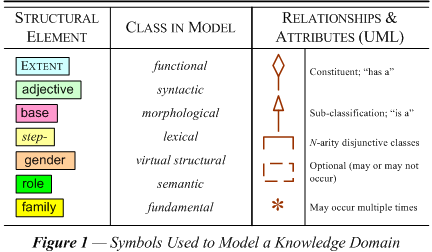
Modeling knowledge. The unified modeling language (UML) introduced in chapter 2 is a widely accepted means of formalizing knowledge in a systematic way. We are concerned about knowledge at several levels of understanding, so we have come to use boxes of various colors for these different levels of analysis. Figure 1 lists the functional model on the top with its cyan color and label in small caps. This view sees words as linguistic expressions functioning in their particular culture. The next three levels describe 1) the arrangement of words (light green), 2) the internal composition of words (rose), and 3) the words themselves as they convey meaning (light yellow). The meanings are often structured into a hierarchy of classes (tan). I call this “virtual” because the common statement of rules often leaves them implicit. The semantic field is divided into classes (bright green) representing combinations of fundamental concepts (bright yellow).

Furthermore the boxes of a UML diagram are joined by arrows designating two different class relationships. The first arrow is headed by a diamond and means that the class being pointed to contains it as a constituent part. The second arrow is headed by a triangle and means that the class is a subclass of the class being pointed to. The various subclasses are joined by a square brace when they are alternative structural classes. The box is enclosed with a dashed line to indicate its being optional. A star is placed by the arrow if there might be multiple instances of the constituent.
Kinship rules. The rules characterizing the semantic structure of kinship chains may be devised by setting up classes for each of the fundamental elements and giving their syntax (structural arrangement). Figure 2 uses Backus-Naur form (BNF) to put some of these classes together into components that are then in turn characterized as parts of other components. The first rule says that a kinship (chain) consists of at least four parts: 1) the “persona” together with 2) the “ego” indicator augmented with 3) one or more “extensions” joined by 4) a “role” indicator.
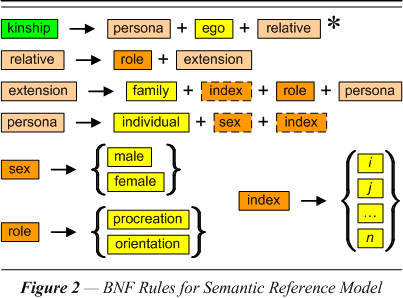
The second and third rules give the constituency of the extension and the persona. The parentheses are the BNF way of indicating optional classes. Notice that the bright yellow boxes are not analyzed further. Mutually exclusive classes are placed in a column within curly braces.
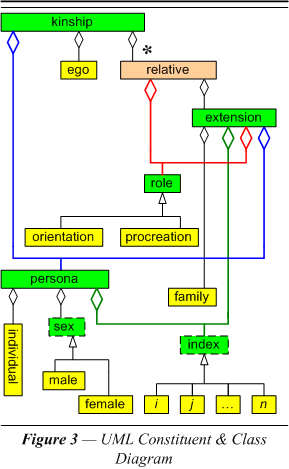
Figure 3 is a UML diagram of the same facts captured by BNF rules in figure 2. The extra box labeled “relative” is required to express the multiple occurrence of the ordered set of boxes attached to it. This is an example of virtual structure required because of the formal requirements of the rule format. It is also important to realize that the UML diagram allows multiple instances of boxes in the BNF rules to be brought together into a single box. This is called “normalization.” Normalization is what brings about the crossing of some of the relationship arrows. We will find later that sometimes it will make it most convenient for some lines to pass across other boxes.
Kinship structures & chains. It is possible to show that the kinship chains introduced in section 6-1 are just those characterized by the BNF rules and UML diagrams. To do so, however, we need to have a few additional rules of another kind. I am puzzled as to the best way to state such rules. What we need is to map the fundamental elements of the hierarchical syntax in an individual instance to the corresponding instance in the symbolic model. The rule also needs to generalize the instances into syntactic classes. We give a provisional form of these rules in figure 4:
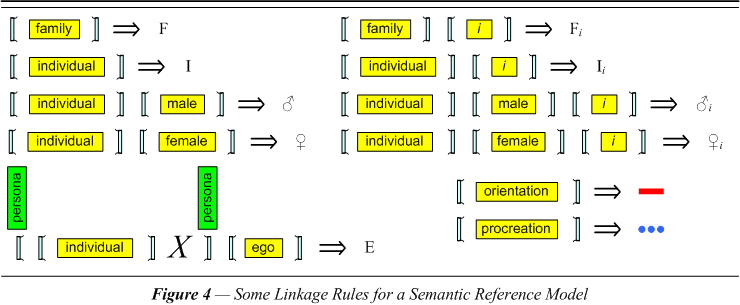
The square brackets are meant to designate the element enclosed as a structural segment generated, i.e., characterized, by the BNF rule. The idea in the first rule is that any “family” element maps to an “F” in the symbolic kinship chain. The double arrow stands for the mapping function that allows the expression on the left to be replaced by the expression on the right. Sometimes the square brackets need to be labeled. The rule in the bottom left has labels to restrict the instances to those where the “ego” is directly adjoining the “individual.” In this case we needed to designate the arbitrary structures that correspond to optional elements by referring to them with an X as a variable expression. These elements on the left are all absorbed into the single undifferentiated “E” symbol
Kinship elements in FOPC. A diagram illustrating the linkage of the semantic structure to the symbolic language of kinship chains will be found in section C-5. In that section we take on the additional task of linking the linguistic structure of kinship terms to this semantic structure. In later sections it will become apparent that the greater task of using the first order predicate calculus (FOPC) to represent meaning will be unavoidable. The implication is that the above rules may eventually be replaced by rules suited to going directly to expressions of this more fundamental calculus. The FOPC has been used to model the domain of natural human language. To understand how this is done in the most direct way consider the expressions in figure 5.
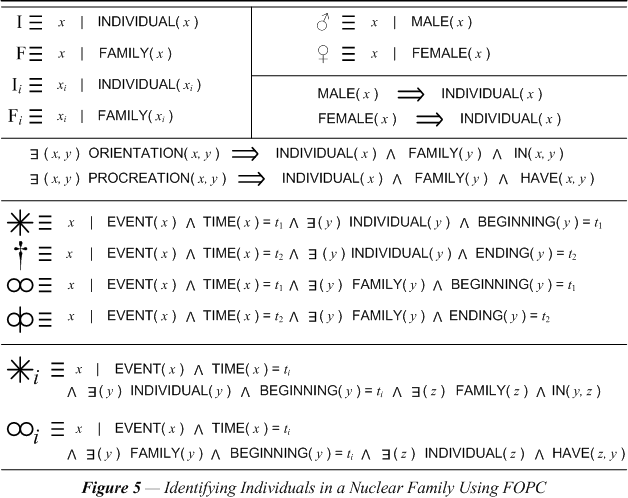
Compare this diagram with the meanings of the individual and family symbols introduced with figure 2 in the introduction to section C-2. Here the indentity (≡) mark is used to represent the mapping from the symbols to the predicates of this more fundamental calculus. If the reader is not fully conversant with the conventions of FOPC, here are a few interpretations. The virgule is normally read as “such that.” The double arrow is the sign for material implication, which is normally read as “implies that” It is important that the expressions on either side of this sign are propositions, i.e., clauses taken as be being either true or false any valid context. Be aware that the inverted “V” is what we in English usually mean with “and.” It is possible to get an idea of the meaning of the quantification operator (the inverted “E”) by phrasing it as “there exist(s) . . . such that”. The last line might be read as: “the double ring subscripted with some integer (i) represents some value (x) such that it is an event that occurred at the time (t) distinguished by that integer and there is another value (y) which is a family which had a beginning at that time and there is a third value (z) which is an individual who is a principal in that family.” Normally the multiple events of this type belonging to a particular principal are ordered by their time value, so that the integers are in sequence and the family is spoken of as from the principal’s i-th marriage.
